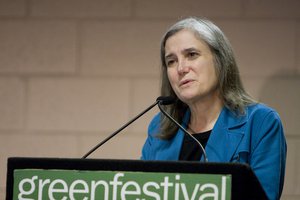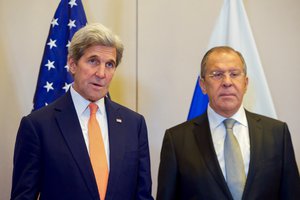- published: 04 Jul 2015
- views: 76737
-
remove the playlistBiology
-
remove the playlistLatest Videos
- remove the playlistBiology
- remove the playlistLatest Videos
- published: 05 Sep 2012
- views: 147503
- published: 26 Jun 2009
- views: 3370785
- published: 28 Sep 2016
- views: 3525
- published: 21 Aug 2013
- views: 142115
- published: 28 Apr 2016
- views: 4911846
- published: 24 Feb 2012
- views: 145169
- published: 16 Sep 2015
- views: 137224
- published: 24 Sep 2015
- views: 92496
- published: 30 Jan 2012
- views: 2776864

Mutualism (biology)
Mutualism is the way two organisms of different species exist in a relationship in which each individual benefits from the activity of the other. Similar interactions within a species are known as co-operation. Mutualism can be contrasted with interspecific competition, in which each species experiences reduced fitness, and exploitation, or parasitism, in which one species benefits at the expense of the other. Symbiosis is a broad category that is defined to include relationships that are mutualistic, parasitic, or commensal. Mutualism is one type of symbiosis.
A well-known example of mutualism is the relationship between ungulates (such as bovines) and bacteria within their intestines. The ungulates benefit from the cellulase produced by the bacteria, which facilitates digestion; the bacteria benefit from having a stable supply of nutrients in the host environment. This can also be found in many many different symbiotic relationships.
Mutualism plays a key part in ecology. For example, mutualistic interactions are vital for terrestrial ecosystem function as more than 48% of land plants rely on mycorrhizal relationships with fungi to provide them with inorganic compounds and trace elements. In addition, mutualism is thought to have driven the evolution of much of the biological diversity we see, such as flower forms (important for pollination mutualisms) and co-evolution between groups of species. However mutualism has historically received less attention than other interactions such as predation and parasitism.
This article is licensed under the Creative Commons Attribution-ShareAlike 3.0 Unported License, which means that you can copy and modify it as long as the entire work (including additions) remains under this license.

Biology
Biology is a natural science concerned with the study of life and living organisms, including their structure, function, growth, evolution, distribution, and taxonomy. Modern biology is a vast and eclectic field, composed of many branches and subdisciplines. However, despite the broad scope of biology, there are certain general and unifying concepts within it that govern all study and research, consolidating it into single, coherent fields. In general, biology recognizes the cell as the basic unit of life, genes as the basic unit of heredity, and evolution as the engine that propels the synthesis and creation of new species. It is also understood today that all organisms survive by consuming and transforming energy and by regulating their internal environment to maintain a stable and vital condition.
Subdisciplines of biology are defined by the scale at which organisms are studied, the kinds of organisms studied, and the methods used to study them: biochemistry examines the rudimentary chemistry of life; molecular biology studies the complex interactions among biological molecules; botany studies the biology of plants; cellular biology examines the basic building-block of all life, the cell; physiology examines the physical and chemical functions of tissues, organs, and organ systems of an organism; evolutionary biology examines the processes that produced the diversity of life; and ecology examines how organisms interact in their environment.
This article is licensed under the Creative Commons Attribution-ShareAlike 3.0 Unported License, which means that you can copy and modify it as long as the entire work (including additions) remains under this license.
- Loading...

-
 5:32
5:32How To Get an A in Biology
How To Get an A in BiologyHow To Get an A in Biology
Hi Everyone! So in this video I discuss how I studied for biology and how I did well in my classes. I know that some of you are going to be like..... she technically didn't get an A in all of her bio classes, but I received an A in a majority of them which is why I titled this video "how to get an A in biology". I hope you guys enjoy and although I reference a lot of other videos I hope you guys understand! Thank you so much for watching! Love, Gabby __________________________ C O N N E C T Instagram: @gabbyaikawa https://www.instagram.com/gabbyaikawa/ Email gabriella.aikawa@gmail.com Facebook: https://www.facebook.com/makeupwarrior1 Twitter: @Makeupwarrior1 https://twitter.com/makeupwarrior1 __________________________ V I D E O S M E N T I O N E D Study Schedule: https://www.youtube.com/watch?v=SSzElFmoaqA Study Guide: https://www.youtube.com/watch?v=IMa4H99blms Universal Tip: https://www.youtube.com/watch?v=G8OIFIoE9rs -
 4:20
4:20Biology Lecture - 1 - Introduction to Biology
Biology Lecture - 1 - Introduction to BiologyBiology Lecture - 1 - Introduction to Biology
All my videos - https://thenewboston.com/videos.php Support my tutorials - https://www.patreon.com/thenewboston Forum - https://thenewboston.com/forum/ Bucky Roberts - https://thenewboston.com/profile.php?user=2 Facebook - https://www.facebook.com/TheNewBoston-464114846956315/ GitHub - https://github.com/buckyroberts Google+ - https://plus.google.com/+BuckyRoberts LinkedIn - https://www.linkedin.com/in/bucky-roberts-69272170 Reddit - https://www.reddit.com/r/thenewboston/ Twitter - https://twitter.com/bucky_roberts -
 3:42
3:42Girls Aloud - Biology
Girls Aloud - Biology -
 87:13
87:13It's Alive, But Is It Life: Synthetic Biology and the Future of Creation
It's Alive, But Is It Life: Synthetic Biology and the Future of CreationIt's Alive, But Is It Life: Synthetic Biology and the Future of Creation
For decades, biologists have read and edited DNA, the code of life. Revolutionary developments are giving scientists the power to write it. Instead of tinkering with existing life forms, synthetic biologists may be on the verge of writing the DNA of a living organism from scratch. In the next decade, according to some, we may even see the first synthetic human genome. Join a distinguished group of synthetic biologists, geneticists and bioengineers who are edging closer to breathing life into matter. Original Program Date: June 4, 2016 MODERATOR: Robert Krulwich PARTICIPANTS: George Church, Drew Endy, Tom Knight, Pamela Silver Subscribe to our YouTube Channel for all the latest from WSF. Visit our Website: http://www.worldsciencefestival.com/ Like us on Facebook: https://www.facebook.com/worldsciencefestival Follow us on twitter: https://twitter.com/WorldSciFest Synthetic Biology and the Future of Creation 00:05 Participant Intros 3:25 Ordering DNA from the internet 8:10 How much does it cost to make a synthetic human? 13:04 Why is yeast the best catalyst 20:10 How George Church printed 90 billion copies of his book 26:05 Creating synthetic rose oil 28:35 Safety engineering and synthetic biology 37:15 Do we want to be invaded by bad bacteria? 45:26 Do you need a human gene's to create human cells? 55:09 The standard of DNA sequencing in utero 1:02:27 The science community is divided by closed press meetings 1:11:30 The Human Genome Project. What is it? 1:21:45 -
 4:12
4:12Introduction to Biology HD
Introduction to Biology HDIntroduction to Biology HD
This is a new high definition (HD) dramatic video choreographed to powerful music that introduces the viewer/student to the Science of Biology. It is designed as a motivational "trailer" to be shown by teachers in Biology and Physical Science classrooms in middle school, high school and college as a visual Introduction to the wonders of life. It augments an earlier video on the same topic that I produced 2 years ago. Subscribe to my channel at http://www.youtube.com/user/sfgregs?feature=mhum to see all of my exciting video trailers in Biology, Chemistry, Earth Science and Astronomy. I will be releasing new ones periodically. You can download all of my videos for free from Vimeo, my other video site. The link is available in the "About" section of this channel. Please rate this video and feel free to comment. If you like it, please help me spread the word by posting links to it on your school and social media websites. The more students who can enjoy these dramatic videos, the better! I wish to thank all the quality video and music producers whose postings enabled me to assemble this video for educational use. Music is a mix of two pieces, "The End" by Studio Fontana, and "Dream Chasers" by Future World Music. To best enjoy this video, view on a big screen and turn up your speakers. The music is powerful and dramatic! I can customize this video to add your name or school name at the end credits, for a very modest fee. If interested, email me at "fsgregs@comcast.net" -
 6:38
6:38Brielle's Biology Lesson
Brielle's Biology LessonBrielle's Biology Lesson
The brilliant little 4-year-old is back to share some new knowledge, and try her hand at speaking whale! -
 9:09
9:09Biology
BiologyBiology
Paul Andersen introduces the topic of Biology. He covers each of the four main ideas that were developed by the College Board. These ideas revolve around the concepts of evolution, free energy, information and systems. Intro Music Atribution Title: I4dsong_loop_main.wav Artist: CosmicD Link to sound: http://www.freesound.org/people/CosmicD/sounds/72556/ Creative Commons Atribution License -
 16:10
16:10How Quantum Biology Might Explain Life’s Biggest Questions | Jim Al-Khalili | TED Talks
How Quantum Biology Might Explain Life’s Biggest Questions | Jim Al-Khalili | TED TalksHow Quantum Biology Might Explain Life’s Biggest Questions | Jim Al-Khalili | TED Talks
How does a robin know to fly south? The answer might be weirder than you think: Quantum physics may be involved. Jim Al-Khalili rounds up the extremely new, extremely strange world of quantum biology, where something Einstein once called “spooky action at a distance” helps birds navigate, and quantum effects might explain the origin of life itself. TEDTalks is a daily video podcast of the best talks and performances from the TED Conference, where the world's leading thinkers and doers give the talk of their lives in 18 minutes (or less). Look for talks on Technology, Entertainment and Design -- plus science, business, global issues, the arts and much more. Find closed captions and translated subtitles in many languages at http://www.ted.com/translate Follow TED news on Twitter: http://www.twitter.com/tednews Like TED on Facebook: https://www.facebook.com/TED Subscribe to our channel: http://www.youtube.com/user/TEDtalksDirector -
 9:40
9:4025 Biology Mysteries Humanity Has Not Figured Out Yet
25 Biology Mysteries Humanity Has Not Figured Out Yet25 Biology Mysteries Humanity Has Not Figured Out Yet
Biology mysteries exist all over the place. They can be as small in size as cancerous cells, or as large and imposing as the majestic blue whale. And even though science has been able to uncover many wonders of our world’s biological make up, it still has a long way to go. For example, we still haven’t deciphered Peto’s Paradox. Or pinpointed with certainty the origin of flowers or even the origin of the Ebola virus! That’s only scratching the surface, we still don’t know what the vast majority of our DNA does or how butterflies migrate exactly. Talk about a mess of biological mysteries! It’s a good thing our species is a curious species because we are currently working hard to uncover these mysteries, discoveries that could propel humanity into a new age of prosperity and health. Take the Ebola Virus for example, Canadian scientists have been able to successfully treat monkeys (though sadly, it’s a long way before such measures can be applied to humans). So if you want to know about some of the most unique biology mysteries in our planet, stick around as we share with you these 25 biology mysteries humanity has not figured out yet. Follow us on: Twitter: https://twitter.com/list25 Facebook: https://www.facebook.com/list25 Website: http://list25.com Instagram: https://instagram.com/list25/ Pinterest: https://www.pinterest.com/list25/ Be sure to check out the physical list here: http://list25.com/25-biology-mysteries-humanity-has-not-figured-out-yet/ Butterfly Migration The Loricifera Mystery The Paradox of the Plankton Ebola's origin and place of hiding Perception Alkaloids Adaptation Homing (In Biology) Hammerhead Shark’s Structure Golgi Apparatus Glycogen Body Gall Wasp Fairy Circle (Africa) Evolution of Sex The Function of DNA The Whole Consciousness Thing The History of Flowers Peto’s Paradox Blue Whale’s Sexual Life The Cambrian Explosion Korarchaeota metabolic processes Basking Shark’s Reproduction Mechanism Arthropod Head Problem Biological Aging The Origin of Life Music: Chee Zee Jungle - Primal Drive by Kevin MacLeod is licensed under a Creative Commons Attribution license (https://creativecommons.org/licenses/by/4.0/) Source: http://incompetech.com/music/royalty-free/index.html?isrc=USUAN1100684 Artist: http://incompetech.com/ -
 12:33
12:33That's Why Carbon Is A Tramp: Crash Course Biology #1
That's Why Carbon Is A Tramp: Crash Course Biology #1That's Why Carbon Is A Tramp: Crash Course Biology #1
And thus begins the most revolutionary biology course in history. Come and learn about covalent, ionic, and hydrogen bonds. What about electron orbitals, the octet rule, and what does it all have to do with a mad man named Gilbert Lewis? It's all contained within. Like Crash Course on Facebook: http://www.facebook.com/YouTubeCrashCourse Follow Crash Course on Twitter: http://www.twitter.com/thecrashcourse Chapter Timecode: 1. Re-watch the whole video = 00:00 2. Carbon is a Tramp = 01:51 3. Electron Shells = 04:23 4. The Octet Rule = 06:52 5. Gilbert Lewis = 05:09 6. Covalent Bonds = 04:41 7. Polar & Non-Polar Covalent Bonds = 07:58 8. Ionic Bonds = 08:29 9. Hydrogen Bonds = 10:11 Crash Course Biology is now available on DVD! http://dftba.com/product/1av/CrashCourse-Biology-The-Complete-Series-DVD-Set biology, crashcourse, gilbert lewis, carbon, hydrogen, electron, proton, covalent bonds, ion, octet rule, covalent bonds, polar, non-polar, ionic bond, hydrogen bond, hank green, john green, vlogbrothers, nobel Support CrashCourse on Subbable: http://subbable.com/crashcourse
-

How To Get an A in Biology
Hi Everyone! So in this video I discuss how I studied for biology and how I did well in my classes. I know that some of you are going to be like..... she technically didn't get an A in all of her bio classes, but I received an A in a majority of them which is why I titled this video "how to get an A in biology". I hope you guys enjoy and although I reference a lot of other videos I hope you guys understand! Thank you so much for watching! Love, Gabby __________________________ C O N N E C T Instagram: @gabbyaikawa https://www.instagram.com/gabbyaikawa/ Email gabriella.aikawa@gmail.com Facebook: https://www.facebook.com/makeupwarrior1 Twitter: @Makeupwarrior1 https://twitter.com/makeupwarrior1 __________________________ V I D E O S M E N T I O N E D Study Schedule: https://www.you...
published: 04 Jul 2015 -

Biology Lecture - 1 - Introduction to Biology
All my videos - https://thenewboston.com/videos.php Support my tutorials - https://www.patreon.com/thenewboston Forum - https://thenewboston.com/forum/ Bucky Roberts - https://thenewboston.com/profile.php?user=2 Facebook - https://www.facebook.com/TheNewBoston-464114846956315/ GitHub - https://github.com/buckyroberts Google+ - https://plus.google.com/+BuckyRoberts LinkedIn - https://www.linkedin.com/in/bucky-roberts-69272170 Reddit - https://www.reddit.com/r/thenewboston/ Twitter - https://twitter.com/bucky_roberts
published: 05 Sep 2012 -

Girls Aloud - Biology
Music video by Girls Aloud performing Biology. (C) 2005 Polydor Ltd. (UK)
published: 26 Jun 2009 -

It's Alive, But Is It Life: Synthetic Biology and the Future of Creation
For decades, biologists have read and edited DNA, the code of life. Revolutionary developments are giving scientists the power to write it. Instead of tinkering with existing life forms, synthetic biologists may be on the verge of writing the DNA of a living organism from scratch. In the next decade, according to some, we may even see the first synthetic human genome. Join a distinguished group of synthetic biologists, geneticists and bioengineers who are edging closer to breathing life into matter. Original Program Date: June 4, 2016 MODERATOR: Robert Krulwich PARTICIPANTS: George Church, Drew Endy, Tom Knight, Pamela Silver Subscribe to our YouTube Channel for all the latest from WSF. Visit our Website: http://www.worldsciencefestival.com/ Like us on Facebook: https://www.facebook.com/...
published: 28 Sep 2016 -

Introduction to Biology HD
This is a new high definition (HD) dramatic video choreographed to powerful music that introduces the viewer/student to the Science of Biology. It is designed as a motivational "trailer" to be shown by teachers in Biology and Physical Science classrooms in middle school, high school and college as a visual Introduction to the wonders of life. It augments an earlier video on the same topic that I produced 2 years ago. Subscribe to my channel at http://www.youtube.com/user/sfgregs?feature=mhum to see all of my exciting video trailers in Biology, Chemistry, Earth Science and Astronomy. I will be releasing new ones periodically. You can download all of my videos for free from Vimeo, my other video site. The link is available in the "About" section of this channel. Please rate this video ...
published: 21 Aug 2013 -

Brielle's Biology Lesson
The brilliant little 4-year-old is back to share some new knowledge, and try her hand at speaking whale!
published: 28 Apr 2016 -

Biology
Paul Andersen introduces the topic of Biology. He covers each of the four main ideas that were developed by the College Board. These ideas revolve around the concepts of evolution, free energy, information and systems. Intro Music Atribution Title: I4dsong_loop_main.wav Artist: CosmicD Link to sound: http://www.freesound.org/people/CosmicD/sounds/72556/ Creative Commons Atribution License
published: 24 Feb 2012 -

How Quantum Biology Might Explain Life’s Biggest Questions | Jim Al-Khalili | TED Talks
How does a robin know to fly south? The answer might be weirder than you think: Quantum physics may be involved. Jim Al-Khalili rounds up the extremely new, extremely strange world of quantum biology, where something Einstein once called “spooky action at a distance” helps birds navigate, and quantum effects might explain the origin of life itself. TEDTalks is a daily video podcast of the best talks and performances from the TED Conference, where the world's leading thinkers and doers give the talk of their lives in 18 minutes (or less). Look for talks on Technology, Entertainment and Design -- plus science, business, global issues, the arts and much more. Find closed captions and translated subtitles in many languages at http://www.ted.com/translate Follow TED news on Twitter: http://ww...
published: 16 Sep 2015 -

25 Biology Mysteries Humanity Has Not Figured Out Yet
Biology mysteries exist all over the place. They can be as small in size as cancerous cells, or as large and imposing as the majestic blue whale. And even though science has been able to uncover many wonders of our world’s biological make up, it still has a long way to go. For example, we still haven’t deciphered Peto’s Paradox. Or pinpointed with certainty the origin of flowers or even the origin of the Ebola virus! That’s only scratching the surface, we still don’t know what the vast majority of our DNA does or how butterflies migrate exactly. Talk about a mess of biological mysteries! It’s a good thing our species is a curious species because we are currently working hard to uncover these mysteries, discoveries that could propel humanity into a new age of prosperity and health. Take the...
published: 24 Sep 2015 -

That's Why Carbon Is A Tramp: Crash Course Biology #1
And thus begins the most revolutionary biology course in history. Come and learn about covalent, ionic, and hydrogen bonds. What about electron orbitals, the octet rule, and what does it all have to do with a mad man named Gilbert Lewis? It's all contained within. Like Crash Course on Facebook: http://www.facebook.com/YouTubeCrashCourse Follow Crash Course on Twitter: http://www.twitter.com/thecrashcourse Chapter Timecode: 1. Re-watch the whole video = 00:00 2. Carbon is a Tramp = 01:51 3. Electron Shells = 04:23 4. The Octet Rule = 06:52 5. Gilbert Lewis = 05:09 6. Covalent Bonds = 04:41 7. Polar & Non-Polar Covalent Bonds = 07:58 8. Ionic Bonds = 08:29 9. Hydrogen Bonds = 10:11 Crash Course Biology is now available on DVD! http://dftba.com/product/1av/CrashCourse-Biology-The-Complete-...
published: 30 Jan 2012
How To Get an A in Biology
- Order: Reorder
- Duration: 5:32
- Updated: 04 Jul 2015
- views: 76737
- published: 04 Jul 2015
- views: 76737
Biology Lecture - 1 - Introduction to Biology
- Order: Reorder
- Duration: 4:20
- Updated: 05 Sep 2012
- views: 147503
- published: 05 Sep 2012
- views: 147503
Girls Aloud - Biology
- Order: Reorder
- Duration: 3:42
- Updated: 26 Jun 2009
- views: 3370785
- published: 26 Jun 2009
- views: 3370785
It's Alive, But Is It Life: Synthetic Biology and the Future of Creation
- Order: Reorder
- Duration: 87:13
- Updated: 28 Sep 2016
- views: 3525
- published: 28 Sep 2016
- views: 3525
Introduction to Biology HD
- Order: Reorder
- Duration: 4:12
- Updated: 21 Aug 2013
- views: 142115
- published: 21 Aug 2013
- views: 142115
Brielle's Biology Lesson
- Order: Reorder
- Duration: 6:38
- Updated: 28 Apr 2016
- views: 4911846
- published: 28 Apr 2016
- views: 4911846
Biology
- Order: Reorder
- Duration: 9:09
- Updated: 24 Feb 2012
- views: 145169
- published: 24 Feb 2012
- views: 145169
How Quantum Biology Might Explain Life’s Biggest Questions | Jim Al-Khalili | TED Talks
- Order: Reorder
- Duration: 16:10
- Updated: 16 Sep 2015
- views: 137224
- published: 16 Sep 2015
- views: 137224
25 Biology Mysteries Humanity Has Not Figured Out Yet
- Order: Reorder
- Duration: 9:40
- Updated: 24 Sep 2015
- views: 92496
- published: 24 Sep 2015
- views: 92496
That's Why Carbon Is A Tramp: Crash Course Biology #1
- Order: Reorder
- Duration: 12:33
- Updated: 30 Jan 2012
- views: 2776864
- published: 30 Jan 2012
- views: 2776864
-

mutualism biology project
L
published: 02 Oct 2016 -

Mutualism - Toby Clements
This is my presentation for my biology class on mutualism. References: http://www.dictionary.com/browse/mutualism http://www.necsi.edu/projects/evolution/co-evolution/mutualistic/co-evolution_mutualistic.html http://www2.mcdaniel.edu/Biology/eco/mut/mutualism.html https://sites.google.com/site/apesenvironmentalrelationships/mutualism
published: 25 Apr 2016 -

Biology Organisms & Population part 22 (Population Interaction : Mutualism) class 12 XII
Biology Organisms & Population part 22 (Population Interaction : Mutualism) class 12 XII
published: 29 Feb 2016 -

Preditation, Parasitism, Mutualism, and Commensalism
For Mr. Mason's Biology class. Used: Windows Movie Maker Windows Paint (Very low-budget) No mice were hurt in the making of this film
published: 22 Feb 2016 -

Mutualism: lessons from ants and aphids
Dr. Aniek Ivens discusses the fun of studying ants that farm aphids inside their nests and how hey can help us solve one of the biggest mysteries in biology - the evolution of mutualism Interview was part of the training curriculum offered by the Alan Alda Center for Communicating Science, Stony Brook, NY.
published: 20 Jan 2016 -

Dr. Judith Bronstein: The Conservation Biology of Mutualism
Faça Agora seu Cadastro para Receber Conteúdos Gratuitos sobre Biologia da Conservação: http://biologiadaconservacao.com.br/cadastre-se/ -- Durante sua visita ao Brasil, a Drª. Judith Bronstein (referência mundial em mutualismo) foi convidada pelo Professor Dr. Marco Mello (https://marcoarmello.wordpress.com/) para ministrar uma palestra intitulada "The Conservation Biology of Mutualism"*. O evento aconteceu na sala da pós-graduação em Ecologia, Conservação e Manejo da Vida Silvestre da Universidade Federal de Minas Gerais no dia 23 de junho de 2015 e teve a cobertura da Bocaina Biologia da Conservação. -- * Esta palestra foi apresentada em inglês, e não foi traduzida para o português nem qualquer outra língua. Você está convidado a nos ajudar a legendá-la :) _______ Professor Dr...
published: 06 Jul 2015 -

Mutualism Biology
published: 03 Jul 2015 -

-

Biology,(Lec4,Predation, Parasitism, Symbiosis and Mutualism(Ecology & Environment),Class 12 XII
12 Class Biology,Predation, Parasitism, Symbiosis and Mutualism(Ecology & Environment),CBSE. Information about different type of relationship among different organisms that include Predation-Prey relationship, Parasitism, Symbiosis, Commensalism and grazing. Buy Full Video For Rs. 200 At www.sci4you.com
published: 05 Jun 2015 -

Ecological Interactions: Mutualism and Commensalism
Ecological Interactions displaying mutualism and commensalism. By: Scott Taylor, Carson Woodward, and Jordan Ames
published: 01 Apr 2015
mutualism biology project
- Order: Reorder
- Duration: 0:09
- Updated: 02 Oct 2016
- views: 4
- published: 02 Oct 2016
- views: 4
Mutualism - Toby Clements
- Order: Reorder
- Duration: 4:31
- Updated: 25 Apr 2016
- views: 5
- published: 25 Apr 2016
- views: 5
Biology Organisms & Population part 22 (Population Interaction : Mutualism) class 12 XII
- Order: Reorder
- Duration: 6:08
- Updated: 29 Feb 2016
- views: 1394
- published: 29 Feb 2016
- views: 1394
Preditation, Parasitism, Mutualism, and Commensalism
- Order: Reorder
- Duration: 1:31
- Updated: 22 Feb 2016
- views: 74
- published: 22 Feb 2016
- views: 74
Mutualism: lessons from ants and aphids
- Order: Reorder
- Duration: 3:52
- Updated: 20 Jan 2016
- views: 94
- published: 20 Jan 2016
- views: 94
Dr. Judith Bronstein: The Conservation Biology of Mutualism
- Order: Reorder
- Duration: 59:05
- Updated: 06 Jul 2015
- views: 399
- published: 06 Jul 2015
- views: 399
Mutualism Biology
- Order: Reorder
- Duration: 3:08
- Updated: 03 Jul 2015
- views: 8
- published: 03 Jul 2015
- views: 8
Biology,(Lec4,Predation, Parasitism, Symbiosis and Mutualism(Ecology & Environment),Class 12 XII
- Order: Reorder
- Duration: 5:02
- Updated: 05 Jun 2015
- views: 1122
- published: 05 Jun 2015
- views: 1122
Ecological Interactions: Mutualism and Commensalism
- Order: Reorder
- Duration: 0:50
- Updated: 01 Apr 2015
- views: 75
- published: 01 Apr 2015
- views: 75
- Playlist
- Chat
- Playlist
- Chat

How To Get an A in Biology
- Report rights infringement
- published: 04 Jul 2015
- views: 76737

Biology Lecture - 1 - Introduction to Biology
- Report rights infringement
- published: 05 Sep 2012
- views: 147503

Girls Aloud - Biology
- Report rights infringement
- published: 26 Jun 2009
- views: 3370785

It's Alive, But Is It Life: Synthetic Biology and the Future of Creation
- Report rights infringement
- published: 28 Sep 2016
- views: 3525

Introduction to Biology HD
- Report rights infringement
- published: 21 Aug 2013
- views: 142115

Brielle's Biology Lesson
- Report rights infringement
- published: 28 Apr 2016
- views: 4911846

Biology
- Report rights infringement
- published: 24 Feb 2012
- views: 145169

How Quantum Biology Might Explain Life’s Biggest Questions | Jim Al-Khalili | TED Talks
- Report rights infringement
- published: 16 Sep 2015
- views: 137224

25 Biology Mysteries Humanity Has Not Figured Out Yet
- Report rights infringement
- published: 24 Sep 2015
- views: 92496

That's Why Carbon Is A Tramp: Crash Course Biology #1
- Report rights infringement
- published: 30 Jan 2012
- views: 2776864
- Playlist
- Chat

mutualism biology project
- Report rights infringement
- published: 02 Oct 2016
- views: 4

Mutualism - Toby Clements
- Report rights infringement
- published: 25 Apr 2016
- views: 5

Biology Organisms & Population part 22 (Population Interaction : Mutualism) class 12 XII
- Report rights infringement
- published: 29 Feb 2016
- views: 1394

Preditation, Parasitism, Mutualism, and Commensalism
- Report rights infringement
- published: 22 Feb 2016
- views: 74

Mutualism: lessons from ants and aphids
- Report rights infringement
- published: 20 Jan 2016
- views: 94

Dr. Judith Bronstein: The Conservation Biology of Mutualism
- Report rights infringement
- published: 06 Jul 2015
- views: 399

Mutualism Biology
- Report rights infringement
- published: 03 Jul 2015
- views: 8

Mutualism
- Report rights infringement
- published: 24 Jun 2015
- views: 26

Biology,(Lec4,Predation, Parasitism, Symbiosis and Mutualism(Ecology & Environment),Class 12 XII
- Report rights infringement
- published: 05 Jun 2015
- views: 1122

Ecological Interactions: Mutualism and Commensalism
- Report rights infringement
- published: 01 Apr 2015
- views: 75
Breaking: Journalist Amy Goodman May Be Charged with 'Participating in a Riot' for Covering North ...
Edit Alternet 16 Oct 2016Donald Trump challenges Hillary Clinton to 'take a drug test' before final debate
Edit AOL 15 Oct 2016Syria talks in Lausanne end without breakthrough
Edit Reuters 16 Oct 2016U.S., S. Korea: Latest N. Korea missile launch fails
Edit The Japan News 16 Oct 2016[VIDEO]: Report: Saddam Hussein Had Secret Torture Chamber In NYC Embassy
Edit WorldNews.com 14 Oct 2016Maths Becomes Biology's Magic Number
Edit Slashdot 16 Oct 2016‘This Is Us’ Bombshell: Mandy Moore Dishes On Her Secret, Talks Aging On Show And ...
Edit Inquisitr 16 Oct 2016Ready to align development strategies with Nepal: China
Edit Newstrack India 16 Oct 2016PU department begins remedial classes for SC, ST students
Edit The Times of India 16 Oct 2016Donald Trump on India: 'We will be best friends'
Edit Business Insider 16 Oct 2016Missouri S&T; crowns 2016 Homecoming royalty (Missouri University of Science & Technology)
Edit Public Technologies 16 Oct 20164th Indian Institute of Space Science and Technology convocation: 572 students awarded degrees
Edit The Times of India 16 Oct 2016Science exhibition held
Edit The Hindu 16 Oct 2016Fisheries department eyes stable production through RAS
Edit The Times of India 16 Oct 2016Carless in Nashville (Lyft Inc)
Edit Public Technologies 16 Oct 2016Wolves Unable to Overcome First Half Deficit from Duluth (Northern State University Athletics)
Edit Public Technologies 16 Oct 2016The conundrum of mind and matter: what is consciousness?
Edit The Guardian 16 Oct 2016- 1
- 2
- 3
- 4
- 5
- Next page »








